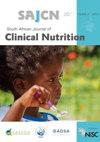Should fast-food nutritional labelling in South Africa be mandatory?
IF 0.8
Q4 NUTRITION & DIETETICS
引用次数: 0
Abstract
Objectives: This study aimed to: (i) determine the proportion of fast-food restaurants that provide nutritional information, (ii) describe the nutritional information of similar food items and meal combinations across the fast-food restaurants, (iii) and use a graphical labelling system to describe these data. Methods: Thirty-one of the biggest fast-food restaurants in South Africa were included to estimate the proportion of those that provided nutritional information on their websites/outlets. Energy, protein, fat, carbohydrate, salt and sugar nutrient compositions were compared for similar food items (burger or pizza), and a meal combination that included burger/pizza, medium-size fried chips and a sugar-sweetened beverage. The UK Traffic Light labelling system was used to compare fat, salt and sugar across restaurants. Results: Only 58% of the restaurants provided some form of nutritional information. While all burgers were high in protein, some were also high in fat, salt and sugar, as indicated by percentages of the nutritional reference ranges above 30%. Similarly, this was the case for pizzas. All meal combinations particularly exceeded the total recommended energy, carbohydrates, sugar and salt content, and most also exceeded the recommended fat content. Conclusions: Consumption of popular South African fast foods may disproportionally contribute to the daily intakes of total energy, fat, salt and sugar, especially when consumed as combination meals including fried chips and sugar-sweetened beverages. Recommendations: Consumers should limit their fast-food intake and avoid eating meal combinations. The South African Government’s commitment to curb the rise of non-communicable diseases should consider regulations that mandate nutritional labelling of fast foods, to assist consumers in making informed dietary choices.南非的快餐营养标签应该是强制性的吗?
目的:本研究旨在:(i)确定提供营养信息的快餐店的比例,(ii)描述快餐店中类似食物和膳食组合的营养信息,(iii)并使用图形标签系统来描述这些数据。方法:纳入南非31家最大的快餐店,估计在其网站/门店上提供营养信息的比例。比较了类似食物(汉堡或披萨)的能量、蛋白质、脂肪、碳水化合物、盐和糖营养成分,以及包括汉堡/披萨、中等大小的炸薯条和加糖饮料在内的膳食组合。英国红绿灯标签系统用于比较不同餐厅的脂肪、盐和糖。结果:只有58%的餐馆提供某种形式的营养信息。虽然所有汉堡都富含蛋白质,但一些汉堡的脂肪、盐和糖含量也很高,营养参考范围的百分比超过30%。同样,披萨也是如此。所有膳食组合都特别超过了推荐的能量、碳水化合物、糖和盐的总含量,大多数也超过了建议的脂肪含量。结论:食用受欢迎的南非快餐可能会对每日总能量、脂肪、盐和糖的摄入量产生不成比例的影响,尤其是当作为包括炸薯条和加糖饮料在内的组合餐食用时。建议:消费者应限制快餐食品的摄入量,避免食用混合餐。南非政府致力于遏制非传染性疾病的增加,应考虑制定规定快餐营养标签的法规,以帮助消费者做出明智的饮食选择。
本文章由计算机程序翻译,如有差异,请以英文原文为准。
求助全文
约1分钟内获得全文
求助全文
来源期刊

South African Journal of Clinical Nutrition
NUTRITION & DIETETICS-
CiteScore
2.50
自引率
9.10%
发文量
21
期刊介绍:
1.The Journal accepts articles from all basic and applied areas of dietetics and human nutrition, including clinical nutrition, community nutrition, food science, food policy, food service management, nutrition policy and public health nutrition. 2.The Journal has a broad interpretation of the field of nutrition and recognizes that there are many factors that determine nutritional status and that need to be the subject of scientific investigation and reported in the Journal. 3.The Journal seeks to serve a broad readership and to provide information that will be useful to the scientific community, the academic community, government and non-government stakeholders in the nutrition field, policy makers and industry.
 求助内容:
求助内容: 应助结果提醒方式:
应助结果提醒方式:


